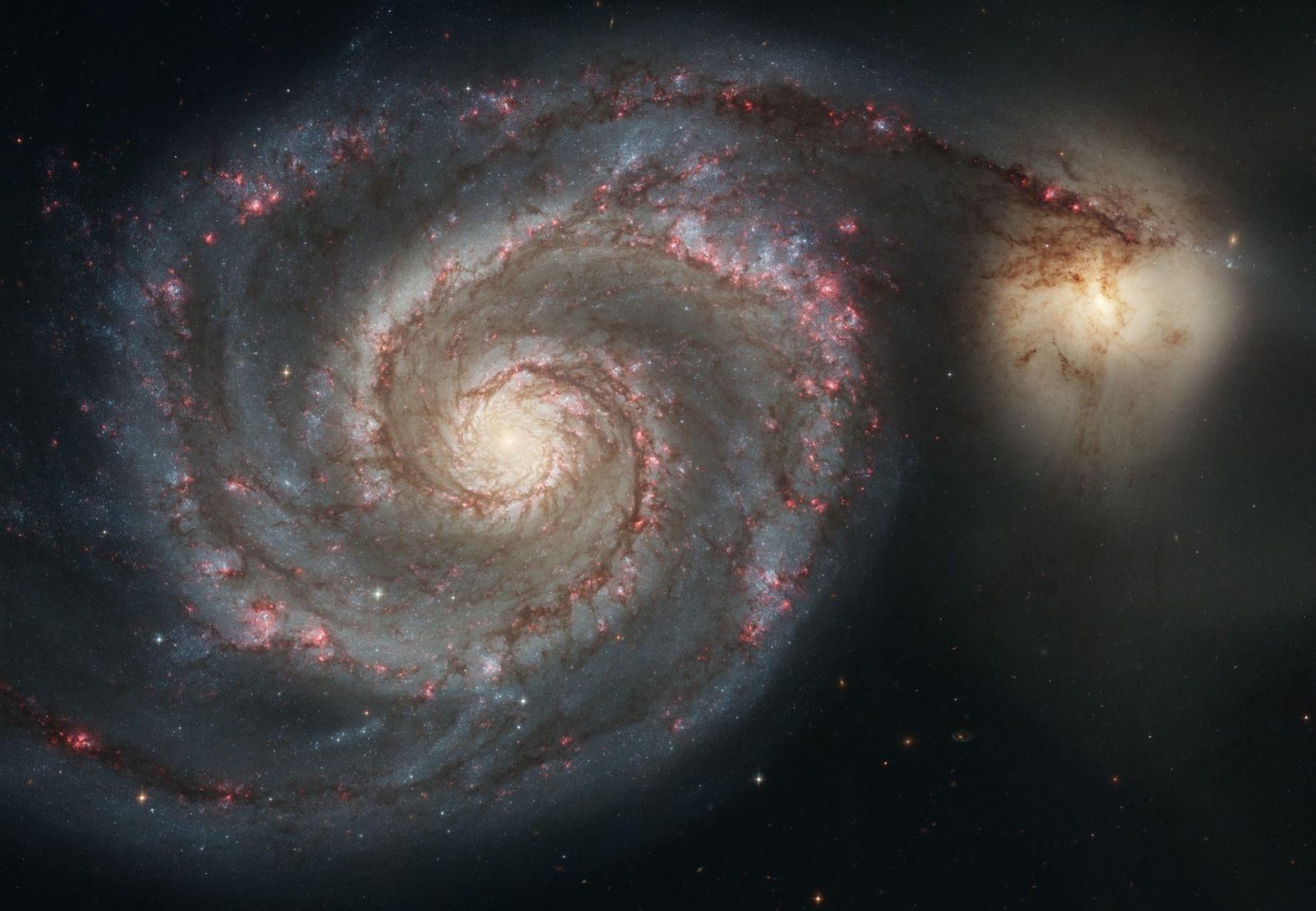


NASA's Hubble Space Telescope captures a stunning, high-resolution image of the spiral galaxy IC 1954, located 45 million light-years away. With the help of other telescopes, this image provides crucial information about the process of star formation and the evolution of galaxies. The data from different wavelengths reveals the active regions where stars are being born and provides a foundation for ongoing research into galactic evolution and the forces shaping the universe.
Hubble Captures Stunning Image of Spiral Galaxy IC 1954
NASA's Hubble Space Telescope has unveiled a breathtaking, high-resolution image of the spiral galaxy IC 1954, situated approximately 45 million light-years away. This image offers valuable insights into star formation and galactic evolution.
Background on Spiral Galaxies
Spiral galaxies, like IC 1954, are characterized by their distinct spiral arms. These arms are regions of intense star formation where gas and dust condense to form new stars. The rotation of the galaxy causes the arms to sweep through space, creating the characteristic spiral pattern.
Star Formation and Galactic Evolution
IC 1954's image allows astronomers to study the process of star formation within the galaxy. The data from the Hubble Space Telescope and other telescopes reveals regions where stars are actively being born. This information helps scientists understand how galaxies evolve and the forces that shape their structure.
Composition and Findings
The image reveals a wealth of detail about IC 1954's composition and structure. The spiral arms are filled with bright, young stars and star-forming regions. The center of the galaxy contains a bright nucleus, suggesting the presence of a supermassive black hole.
Ongoing Research
The data gathered from IC 1954 will serve as a foundation for ongoing research into galactic evolution. Scientists will use this information to investigate the factors that influence star formation, the distribution of matter within galaxies, and the forces that drive their evolution.
Top 5 FAQs about Hubble and NASA's Cosmic Research
1. What is the Hubble Space Telescope?
The Hubble Space Telescope is an optical and ultraviolet space telescope launched into orbit in 1990. It has revolutionized our understanding of the universe, providing stunning images and invaluable data about distant galaxies, stars, and other celestial objects.
2. What is the significance of IC 1954's image?
IC 1954's image provides a detailed snapshot of a nearby spiral galaxy, revealing insights into star formation, galactic structure, and the evolution of the universe.
3. What other tools are being used to study IC 1954?
In addition to the Hubble Space Telescope, other telescopes such as the Spitzer Space Telescope and the Atacama Large Millimeter/submillimeter Array (ALMA) are being used to collect data about IC 1954 at different wavelengths.
4. What are the ongoing challenges in studying galaxies like IC 1954?
Studying distant galaxies poses several challenges, including their immense distances, the presence of dust and gas that obscures our view, and the limitations of our telescopes. However, scientists continue to develop new techniques and instruments to overcome these challenges.
5. What future discoveries can we expect from Hubble and NASA's cosmic research?
As Hubble and other telescopes continue their observations, we can expect to uncover more secrets of the universe. These discoveries may shed light on the birth and evolution of stars, the formation of galaxies, the nature of black holes, and the ultimate fate of our cosmic neighborhood.

Indian Prime Minister Narendra Modi virtually inaugurated Skyroot Aerospace's new Infinity Campus in Hyderabad and unveiled their first orbital launch vehicle, the Vikram-I. During the event, PM Modi praised India's advancements in space technology and spoke about the importance of private companies like Skyroot in driving innovation in the space sector. The Infinity Campus, equipped with state-of-the-art facilities, has the capacity to produce one rocket per month, marking a significant milestone in India's private space manufacturing capability. Skyroot Aerospace, founded by former ISRO engineers, has quickly become a prominent player in India's growing space industry, with the successful launch of Vikram-S, the country's first privately built sub-orbital rocket.

We all experience changes in our mood, whether it's feeling happy and content or irritated and moody. But what are the underlying factors that contribute to these changes? This article from Medindia explores the top 10 things that can affect our mood, from physical health to environmental factors. It also provides tips on how to avoid these mood-altering triggers and maintain a positive state of mind. With a focus on promoting overall well-being, Medindia's policies align with the UN's Sustainable Development Goals, making it a reliable source of information for health and wellness.

A recent report by Public Health Scotland has shown a steep increase in flu cases and hospitalizations in Scotland. The numbers have more than doubled from the previous week, with a higher intensity observed in younger age groups. Experts are warning of a long flu season and a new variant of the illness that is spreading more easily. Health Secretary Neil Gray has assured the public that there are enough doses of flu vaccine available in the country.

The observation of National Pollution Control Day on 2 December serves as a timely reminder of India's struggle with escalating pollution levels. The recent years have seen a sharp increase in toxic particles and hazardous emissions, causing severe health issues and environmental damage. The ongoing pollution emergency calls for more stringent regulations, better urban planning, and increased public engagement to mitigate the crisis.

As World AIDS Day approaches, conversations around HIV prevention in India are becoming more open and informed. In particular, there is growing interest in PrEP (pre-exposure prophylaxis), a medicine that offers strong protection against HIV when used correctly. With rising awareness and more accessible sexual-health services, doctors are seeing a steady rise in patients asking about PrEP as a proactive health choice. This signals a shift towards informed prevention and a stigma-free dialogue surrounding HIV.

ISRO has been making continuous efforts to establish contact with the Vikram lander and Pragyan rover, which were put into sleep mode earlier this month, ahead of the lunar night. However, the prolonged spell of cold weather conditions, reaching up to -150 degrees Celsius, has made it difficult for them to wake up. With the sunrise on the Moon's south polar region and their solar panels believed to be optimally charged now, ISRO is hoping to revive the lander and rover and continue with their experiments and studies. The latest update from ISRO is that the plan to reactivate them has been delayed to September 23 due to the extreme lunar weather conditions.

Monsoon season may bring romantic vibes, but it's also a nightmare for contact lens wearers. Rainwater contains bacteria and pollutants that can cause eye infections, especially when wearing contact lenses. Ophthalmologists recommend using glasses instead and practicing good hygiene to avoid irritation and infection.

India's first human spaceflight mission, Gaganyaan, is one step closer to reality as ISRO successfully tested the main parachutes for the mission's Crew Module. The test, conducted at the Babina Field Firing Range in Uttar Pradesh, is part of the qualification process for the Gaganyaan parachute system. The system, which includes 10 parachutes of different types, is designed to ensure the safe and stable descent of astronauts returning to Earth. This milestone test marks a crucial step forward for India's ambitious space exploration goals.

As World Pneumonia Day is observed on November 12, experts are drawing attention to the dangerous link between air pollution and respiratory illnesses. In India, the post-Diwali smog adds to the already high levels of pollution, increasing the risk of pneumonia, particularly among vulnerable populations. While outdoor air pollution is often blamed, experts emphasize that poor indoor air quality also plays a significant role in triggering and worsening respiratory infections. Health professionals are urging for better air quality regulations and precautions to prevent this deadly connection between pollution and pneumonia.

On November 12, 2025, the world will once again mark World Pneumonia Day, a global health observance highlighting the urgent need to combat one of the leading causes of death, especially in young children. Despite being preventable and treatable, pneumonia continues to claim millions of lives each year, but efforts such as the ‘Every Breath Counts’ coalition and the Global Action Plan for the Prevention and Control of Pneumonia and Diarrhoea are working towards reducing preventable deaths through vaccination and improved healthcare access. Let us continue to raise awareness and take action against this preventable killer.